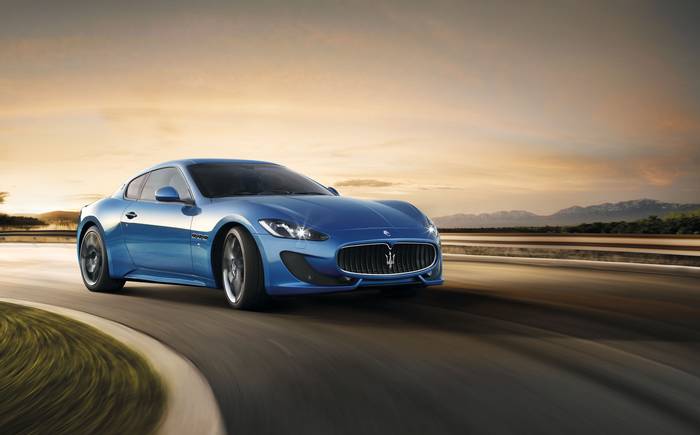Maserati GranTurismo Sport review (2007-on)
The Maserati GranTurismo Sport notches up the performance credentials of the standard model a few pegs.

What is the Maserati Gran Turismo Sport?
The term GranTurismo is familiar to the Playstation generation as a top-flight racing simulation but to the more mature motoring enthusiast with £90,000 burning a hole in their pocket, it means something altogether different ‒ Maserati’s 2+2-seater sports coupé.
The Maserati GranTurismo Sport notches up the performance credentials of the standard model a few pegs. It features a tuned version of the 4.7-litre V8 that sees maximum power rise from 400bhp to 454bhp, as well as a tweaked version of the “Skyhook” damping control system for more agile handling.
Search for and buy a used Maserati GT on driving.co.uk
The Sport retains the styling of its tamer sister but with a few mild changes: the front bumper has been redesigned to improve air flow and front brake cooling, while a subtle clue as to the car’s sporting aspirations comes from the red-accented, chrome trident logo in the centre of the classic Maserati oval grille.
The drive
As a grand tourer the Maserati GranTurismo Sport requires a dual personality ‒ on the one hand it should devour motorway and A-road miles, allowing effortless long-distance cruising; on the other it must be a nimble and powerful companion on back roads. On our test drive the GT Sport despatched both roles with aplomb.
On major roads it darted from London to Scotland and back with ease, its willing V8 barely exceeding tickover in top gear at motorway cruising speeds. Coming off the main arterial routes and onto the twisting B-roads past Glasgow, the car changed character from cruiser to nimble sports car. Activating Sport made the handling more rewarding while, most noticeably, changing the engine note from smooth and refined to one that bellowed, coughing and rasping on the overrun.
The car comes with either an automatic transmission or a semi-auto ’box with large, carbon-fibre paddles mounted on the steering column. It’s a system that works well; the paddles are easy to locate leaving you free to concentrate on more important matters. Up-shifts occur swiftly and downshifts are accompanied by a satisfying blip of the throttle that simulates the effect of heel and toe gearchanges.
Stopping power comes from Brembo six-piston calipers at the front and four-piston calipers at the rear but braking is adequate rather than confidence-inspiring. Hard use also tends to make them fade rather quickly.
The interior
There’s plenty of class here, as you’d expect from a car that starts at more than £90,000. In our test car, white (Bianco Pregiato) leather covered the seats, the centre armrest and the door while the dashboard was lined with contrasting black leather. The traditional, centrally located Maserati analogue clock sits in a rubber surround, which sounds fetishistic but which looks very appealing. There’s also a sprinkling of carbon fibre.
The front seats were comfortable over our multiple hours behind the wheel, and supportive when the car was hustled through quick changes of direction. They’re heated and electrically adjustable and, a nice touch, they feature the Maserati trident embossed in the leather of the headrest. The rear seats are adequate for small people and extra luggage. The car’s long wheelbase means there’s more space here than you’ll find in rival 2+2 GTs such as the Porsche 911 and Jaguar XKR, but it’s still not a place adults will enjoy spending much time.
Switchgear is clearly laid out across the dashboard with, for example, a single button mounted by the steering wheel on the central console to turn sport mode on and off, a single button to switch off ESP (traction control) and even two buttons for adjusting the brightness of the dashboard at night – one to make it brighter, one to make it less so. There are no complicated menus to scroll through; rather a simple and uncluttered button/switch system, and it works.
The biggest drawback? The infotainment system is fairly easy to navigate but it looks dated and lacks the high-tech functionality we’ve come to expect in a car of this price. There’s sat nav and, for phone calls, there’s Bluetooth, though frustratingly playing media over it isn’t possible (you’ll need an audio input cable). Disappointingly, the display is not a touchscreen – something that is de rigeur in rival machines.
What to look out for
GranTurismo owners tend to dote on their cars, so most are in excellent condition. The most common faults centre on the electrics: some of the systems can reset as though the battery has been disconnected. Sometimes the battery is fine but sometimes it drains for no apparent reason; fixes can prove elusive. Early cars didn’t have a Bluetooth option and the factory-fit sat nav is notoriously poor. Interior trim can come adrift while the hood catches on the GranCabrio have a habit of failing.
While the GranCabrio hasn’t been recalled yet, the GranTurismo has suffered from three different production issues. Some early cars could suffer from a failure within the front suspension, while on later models, the seatbelt warning buzzer could stop working and the rear wheels could lock up because of gearbox failure.
The one to buy
Maserati GranTurismo Sport MC Shift 2dr
Factfile
- Price:
- £94,080 (price correct at first publication)
- Engine:
- 4691cc, V8
- Power:
- 454bhp @ 7000rpm
- Torque:
- 384 lb ft @ 4750rpm
- Transmission:
- 6-speed MC Shift semi-auto
- Acceleration:
- 0-62mph in 4.8sec
- Top speed:
- 186mph
- Fuel:
- 18.2mpg (combined)
- CO2:
- 360g/km
- Road tax band:
- M
- Dimensions:
- L 4881mm, W 1915mm, H1353mm
Maserati Gran Turismo Sport used car rivals for similar money




